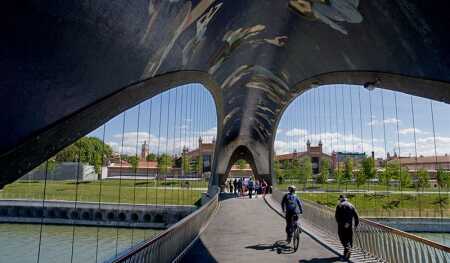Madrid Rio Park
Madrid, Spain
Owner: Madrid City Council
Architects: Burgos & Garrido, Porras & La Casta, Rubio & A-Sala, West 8
Size: 360 acres (146 ha), 6 miles long (9.7 km)
Madrid Rio Park was made possible by the burial of 25 miles (40 km) of urban motorways that had separated Madrid’s 6 million residents from the Manzanares River, which flows through the city. The park now occupies 360 acres (146 ha) of green space, with trails and urban beaches sharing space with art centers, playgrounds, and cafés, providing a link between city and river, and between the urban ecosystem and the vast Manzanares River basin.
The project began in 2005 and continued for a decade, following a 2003 decision by the Madrid City Council to bury the M30 arterial, which ran along both banks of the river. With a bold stroke, the park addressed a severe shortage of freely accessible green spaces in Madrid’s southern neighborhoods, creating a place where the landscape, the city, the architecture, and the urban infrastructure combine to create a greener and more livable city.
Central elements include 12 new pedestrian bridges; 15 acres (6 ha) of public and sports facilities; 18 miles (29 km) of bike lanes; social, communal, and artistic amenities, including two restaurants and six cafés; and children’s areas. The project also involved restoration of the river’s hydraulic architectural heritage, including dams and three historic bridges. Matadero Madrid, an abandoned slaughterhouse converted into an arts center, anchors and enlivens the park. Matadero acts as a cultural catalyst and magnet for people, attracting more than 1 million visitors and hosting 4,000 programs a year.
Nearly wholly built and maintained with public money, the project required political courage and steadfast commitment from the city’s leadership, including Mayor Alberto Ruiz-Gallardón because plans were met with public opposition from the outset. The tunneling of the motorway took more than three years to complete, disrupting traffic and daily life for residents. The complex project and its complicated engineering were also difficult to explain to city dwellers, and its $5 billion price tag was daunting.
Despite these obstacles, today the project helps knit together the southern and northern parts of the city, benefiting some of Madrid’s most disadvantaged neighborhoods, which were disproportionately affected by the motorway, the deterioration of the river, poor connections with the city, and lack of public space. The project has fundamentally improved the city’s urban fabric and is a destination for local neighbors and visitors alike.





